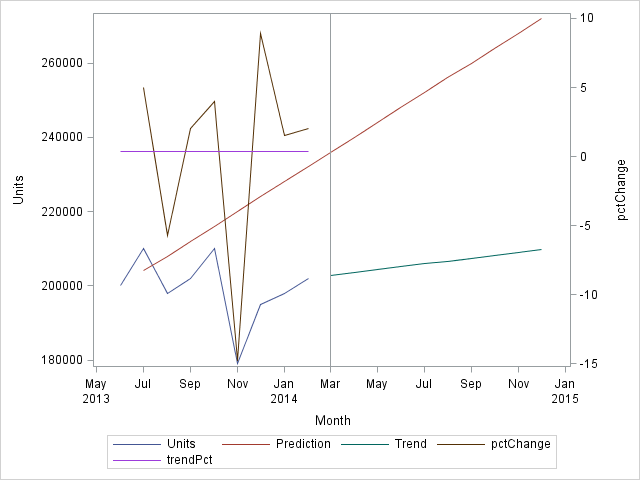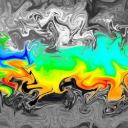- Home
- /
- Analytics
- /
- Forecasting
- /
- Re: Trend function in SAS
- RSS Feed
- Mark Topic as New
- Mark Topic as Read
- Float this Topic for Current User
- Bookmark
- Subscribe
- Mute
- Printer Friendly Page
- Mark as New
- Bookmark
- Subscribe
- Mute
- RSS Feed
- Permalink
- Report Inappropriate Content
Hello all,
I have the following problem (SAS 9.1.3 user):
I have a table containing values like this:
01/2013 2.200.225 units
02/2013 2.250.000 units
03/2013 2.376.999 units
.... ....
02/2014 3.000.100 units
I am looking for a sas function that generates a trend/forecast for these values (for e.g.: 12/2014 trend: 3.255.000). While searching the web I found a function called "proc timeseries", but unfortunately this function is not available in SAS 9.1.3.
Does anyone know a function or solution for my problem?
Thanks in advance and best regards
Cristobal
Accepted Solutions
- Mark as New
- Bookmark
- Subscribe
- Mute
- RSS Feed
- Permalink
- Report Inappropriate Content
I'm not a SAS GRAPH expert, but I do have EG so it generated this code for me when I plotted 4 different variables on the same vertical axis. It looks like you were using 2 axes, but you should still be able to adapt this and use the asterisk for the multiple series on one of the vertical axes:
PROC GPLOT DATA = WORK.SORTTempTableSorted
96 ;
97 PLOT de2_clips * date manual_clip_effort * date autokey_effort * date manual_fullpage_effort * date /
98 OVERLAY
99 VAXIS=AXIS1
100
101 HAXIS=AXIS2
102
103 FRAME LEGEND=LEGEND1
104 ;
105 /* -------------------------------------------------------------------
106 End of task code.
107 ------------------------------------------------------------------- */
108 RUN;
- Mark as New
- Bookmark
- Subscribe
- Mute
- RSS Feed
- Permalink
- Report Inappropriate Content
A linear regression would give you the answer based on a linear trendline..
Proc reg data=have;
model units = date;
run;
This will give you gradient and intercept coefficients that you can apply to the date (in sas date form) to give you a linear estimate.
This code and be emended to include polynomial trend-line fitting as shown to account for higher order relationships:
Proc reg data=have;
model units = date date*date;
run;
- Mark as New
- Bookmark
- Subscribe
- Mute
- RSS Feed
- Permalink
- Report Inappropriate Content
Hello,
thanks for your replay. Unfortunately the reg procedure cannot be found. I get the message "ERROR: Procedure reg not found".
It seems, that this procedure is not available in SAS9.1.3?
Best regards
- Mark as New
- Bookmark
- Subscribe
- Mute
- RSS Feed
- Permalink
- Report Inappropriate Content
Do you have SAS/STAT installed? You can run PROC SETINIT to see what modules are installed.
It is an unusual installation to have SAS/ETS and not SAS/STAT, but that is possible. You can use PROC MODEL as a way to do simple regression if only SAS/ETS is installed.
Steve Denham
- Mark as New
- Bookmark
- Subscribe
- Mute
- RSS Feed
- Permalink
- Report Inappropriate Content
Lag the units, calculate % change, take average (crude way but I know it would work with Base SAS and any version):
01/2013 2.200.225 units .
02/2013 2.250.000 units 2.200.225 0.2%
03/2013 2.376.999 units 2.250.000 5.6%
.... ....
02/2014 3.000.100 units
So the trend after the first 3 months would be 2.9%.
Then put the average of pctchange (ie trend) into a macro variable and bring it back into the data set to do forecast:
proc sql;
select mean(PctChange) into :Trend from...;
quit;
Data Forecast;
set ...;
PredictedUnits = LagUnits * (1+&Trend);
run;
- Mark as New
- Bookmark
- Subscribe
- Mute
- RSS Feed
- Permalink
- Report Inappropriate Content
Hello Steve, hello Chris,
thanks for your answers. Due to weekend I couldn't answer earlier 🙂
It seems that I don't have SAS/STAT installed. I will check whether this is available for me.
Your hint Chris seems to be a good solution for me. I will try whether this works fine.
Best regards
- Mark as New
- Bookmark
- Subscribe
- Mute
- RSS Feed
- Permalink
- Report Inappropriate Content
Ok, now I calculated my trend and my table looks like this:
| Month | Units | Prediction | pctChange | trendPct | Trend |
| 2013/06 | 200000 | 0,38% | |||
| 2013/07 | 210000 | 204000 | 5,00% | 0,38% | |
| 2013/08 | 198000 | 208000 | -5,71% | 0,38% | |
| 2013/09 | 202000 | 212000 | 2,02% | 0,38% | |
| 2013/10 | 210000 | 216000 | 3,96% | 0,38% | |
| 2013/11 | 179000 | 220000 | -14,76% | 0,38% | |
| 2013/12 | 195000 | 224000 | 8,94% | 0,38% | |
| 2014/01 | 198000 | 228000 | 1,54% | 0,38% | |
| 2014/02 | 202000 | 232000 | 2,02% | 0,38% | |
| 2014/03 | 236000 | 202767,6 | |||
| 2014/04 | 240000 | 203538,117 | |||
| 2014/05 | 244000 | 204311,562 | |||
| 2014/06 | 248000 | 205087,946 | |||
| 2014/07 | 252000 | 205867,28 | |||
| 2014/08 | 256000 | 206649,576 | |||
| 2014/09 | 260000 | 207434,844 | |||
| 2014/10 | 264000 | 208223,096 | |||
| 2014/11 | 268000 | 209014,344 | |||
| 2014/12 | 272000 | 209808,599 |
Now I want to print this table in a pdf document.
Till today I only printed the "units per month" and the "prediction per month":
proc gplot data=work.unitsvsprediction;
;
plot units*monat=4 / vaxis=axis1 haxis=axis3 grid;
plot2 prediction*monat=2 / vaxis=axis2;
run;
I tried to extend this statement by plot3 trend*month.... but unfortunately proc gplot doesn't support 3 plots. Is there any other possibility to solve this?
- Mark as New
- Bookmark
- Subscribe
- Mute
- RSS Feed
- Permalink
- Report Inappropriate Content
I'm not a SAS GRAPH expert, but I do have EG so it generated this code for me when I plotted 4 different variables on the same vertical axis. It looks like you were using 2 axes, but you should still be able to adapt this and use the asterisk for the multiple series on one of the vertical axes:
PROC GPLOT DATA = WORK.SORTTempTableSorted
96 ;
97 PLOT de2_clips * date manual_clip_effort * date autokey_effort * date manual_fullpage_effort * date /
98 OVERLAY
99 VAXIS=AXIS1
100
101 HAXIS=AXIS2
102
103 FRAME LEGEND=LEGEND1
104 ;
105 /* -------------------------------------------------------------------
106 End of task code.
107 ------------------------------------------------------------------- */
108 RUN;
- Mark as New
- Bookmark
- Subscribe
- Mute
- RSS Feed
- Permalink
- Report Inappropriate Content
Hello -
Since your data features 2 different dimensions (% and absolute values) for Y values, you may want to look into using the SGPLOT procedure.
Here is an example (I converted your input data to an CSV file).
Thanks,
Udo
data WORK.HAVE ;
infile 'yourpath\have.csv' delimiter = ',' MISSOVER DSD firstobs=2 ;
informat Month anydtdte7. ;
informat Units best.;
informat Prediction best. ;
informat pctChange best. ;
informat trendPct best. ;
informat Trend best. ;
format Month date8. ;
format Units best. ;
format Prediction best. ;
format pctChange best. ;
format trendPct best. ;
format Trend best. ;
input Month Units Prediction pctChange trendPct Trend $;
run;
proc sgplot data=have;
series x=month y=units;
series x=month y=prediction;
series x=month y=trend;
series x=month y=pctchange /y2axis;
series x=month y=trendpct / y2axis;
run;
Results in:

- Mark as New
- Bookmark
- Subscribe
- Mute
- RSS Feed
- Permalink
- Report Inappropriate Content
Hello Chris,
thanks for your answer. The "overlay" option was the keyword. Now it works 🙂
Hello Udo,
I will also try your option with proc sgplot, as it looks very interesting and seems to help for the future 🙂
Best regards
April 27 – 30 | Gaylord Texan | Grapevine, Texas
Registration is open
Walk in ready to learn. Walk out ready to deliver. This is the data and AI conference you can't afford to miss.
Register now and save with the early bird rate—just $795!
- Marketing Minutes | Insights in 20: Streamlining Your Data Into One Consistent View | 14-Jan-2026
- Ask the Expert: Real-Time Agent Assist and Next-Gen Strategy for Financial Services | 15-Jan-2026
- Discovery-based Investigation in SAS Visual Investigator – Your Guide to Better Searches | 20-Jan-2026
- Ask the Expert: The AI Advantage: How SAS Customer Intelligence 360 Solves Real Marketing Challenges | 27-Jan-2026
- DCSUG presents SAS OnDemand for Academics: the Easy Way to Learn SAS For Free for Students, Educator | 27-Jan-2026
- SAS Innovate 2026 | Grapevine, Texas | 27-Apr-2026



